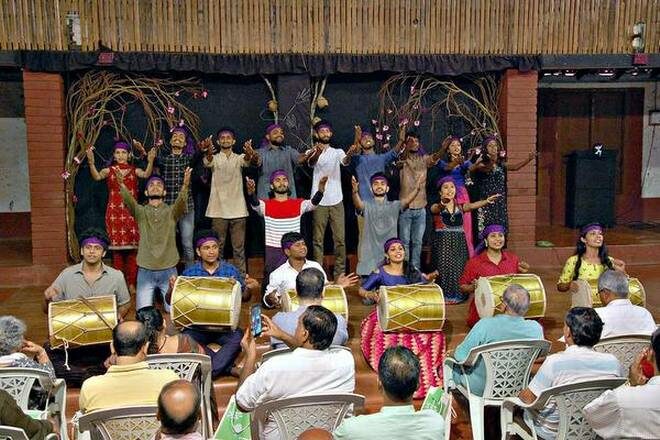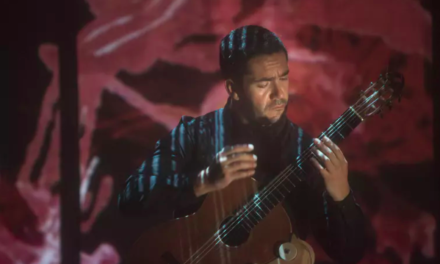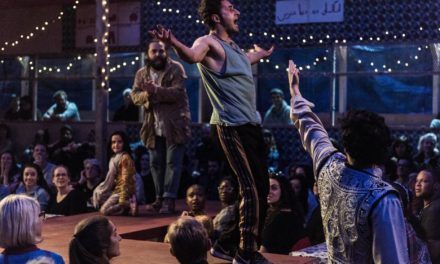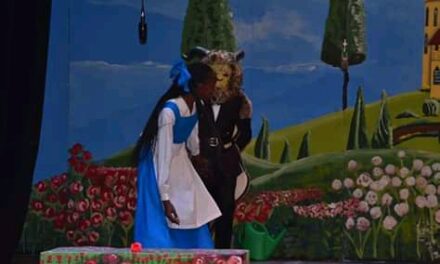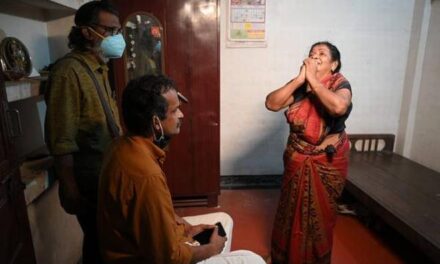The Art Experience workshop at Ninasam, tried to grapple with that experience which is “neither expressible in words nor knowable objectively.”
How do we speak of art? Do we speak of its external attributes: color, texture, shape, size, posture, etc? If we perceive art through its external symbols then–is an experience a sensorium? The iconic Indian philosopher M. Hiriyanna writes in his essay Art Experience, “Those who identify beauty with these external factors and seek it as an attribute forget that while these are perceivable by the senses, beauty is disclosed only to the inward eye. True beauty is neither expressible in words nor knowable objectively, it can only be realized.” Art, therefore, is clearly more than what meets the eye. Art experience is a heart experience, as one finds in the word sahrudaya (one who has a heart that feels similarly).
The theme for the annual culture course at Ninasam, Heggodu, which took place earlier this month, was Art Experience. The theme was explored across a range of artistic expressions — poetry, prose, visual arts, dance, music, cinema, theatre, philosophy, etc. Well-known philosopher Sundar Sarukkai probed the meaning of art, revoking the Kantian thought that ‘nature is beautiful’ and art is a re-presentation of that beautiful. Is art about the individual, is it subjective? “Art” Sundar explained, goes beyond the personal since the social is subsumed in it and hence in its very imagination it is what the community produces. Explaining this with the analogy of poetry, he said the very fact that the poet uses words that are understood by the community, it becomes social. In turn, it becomes art only when it becomes a part of the social evolution and transcends individual excellence. For art experience to take place, the entire universe must be seen as personal. However, does the mere presence of art ensure an experience? Art experience is a fusion of two kinds of prathibha – the karayatri (creative imagination) and bhavayatri (receptive imagination), Sanskrit scholar M.A. Hegde explained, quoting Abhinavagupta. Assuming prathibha in both the artist and sahrudaya, art experience is, therefore, a taught experience. It trains us to unlearn the usual modes of ‘seeing’ and ‘responding.’ Prathibha alone does not make a great artist, one needs to be trained individually and socially and also needs an inherent ability to receive, he said.
Giving examples from Kudiyattam and the Rajasthani folk form Babua, Rustom Bharucha said that while experience takes place in an artistic space, it comes with its own social and aesthetic codes. Thus meaning-making and experience, he explained, are two different things.
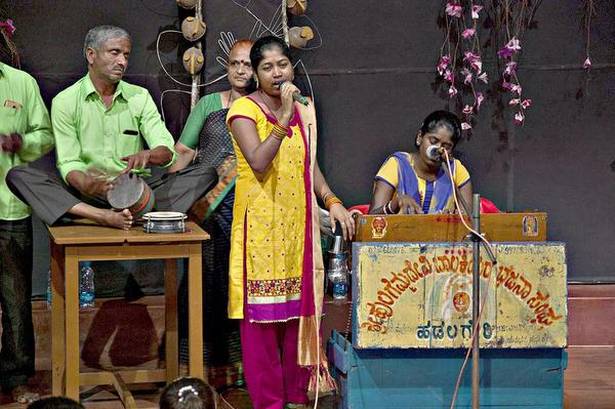
The Art Experience workshop at Ninasam, 2019.
Even when the personal and social in the art are inseparable, can one speak of a uniform experience? Does an experience produce the sameness of meaning to all? It clearly isn’t so. The sense of the social defines the personal, and this was evident in the contrasting trajectories that poets Veena Bannanje and H.S. Venkatesh Murthy drew speaking about poetry. Striking for her conviction, Veena challenged the entire written tradition of literature, sharing space with thinkers like U.G. Krishnamurthi, Aurobindo, Allama Prabhu, and Akka Mahadevi. Writing, she felt, was an expression of the egoistic self (ahankara), but speech intends to connect to the hearts. Classifying the entire Kannada literary tradition into Bhogha Marga and Yoga Marga, Veena said that the bhakti poets and vachanakaras yoked the social with the spiritual in language bare and plain, while the rest of the Kannada poetic tradition indulged in ornamentation and description. She explained her position — with due acknowledgment to the fact that she herself is a writer with published works — referring to descriptions about the woman’s beauty that are available in abundance. Taking the general course of literary readings, H.S. Venkatesh Murthy remarked that poetry is hardly about language, it is about experience: “If it is about language, then why do we not understand all poetry? Art experience teaches us to endure this world, it is about deliquescing for the other,” he added.
Known for her forthrightness and courage, Kannada writer Bhanu Mushtaq has taken on the Muslim clergy like no other. For Bhanu Mushtaq, the spiritual coincided with the act of writing: it was personal, social and political — all at once. “There was a fire within me. It just wouldn’t die. I learned Kannada against everyone’s wishes in the family. I read stories, that was my second act of blasphemy,” she recalled her growing up years. In a telling that was mostly autobiographical, Bhanu Mushtaq narrated her journey in the confines of a conservative Muslim home and how with the support of her husband, she wrote “Muslim Mahileyara Paadu” for Lankesh Patrike (1981). When she began to write stories, it shook the Muslim establishment. “Hell broke loose. I was trolled, they distributed photocopies of my stories, they maligned me, they dragged me around like a dead dog. I couldn’t step out of my home, I had to take psychiatric help. But how could I not write? The manner in which women were treated within the community disturbed me deeply. Through the day, and night, through all my work…it would not leave me.” Today, she said, her writing is under self-censorship. “If I write, they will set my hands on fire. If I don’t, my heart will be on fire.” Caught between personal urgency and ire of the community, art, for Bhanu, was a relentless negotiation. “I have found subtle ways to speak of grave truths.” If art (storytelling) practice was the means by which Bhanu hoped she could expose and challenge the wrongs of the real world; noted writer Jayant Kaikini saw it is a mode of thought. It is that which elevates the every day to the divine. Jayant gave some memorable examples of how art blurs distinctions between the real and the aesthetic. One such was how the late writer, Yashwant Chittal, had once told him about the Dadar station in Mumbai: “This is where Nirmale died.” Later Jayant learned that Chittal was referring to the protagonist in his novel Mooru Daarigalu. The two experiential worlds had fused in Chittal. Art is also that which points to the unsaid through the said, noted Jayant.
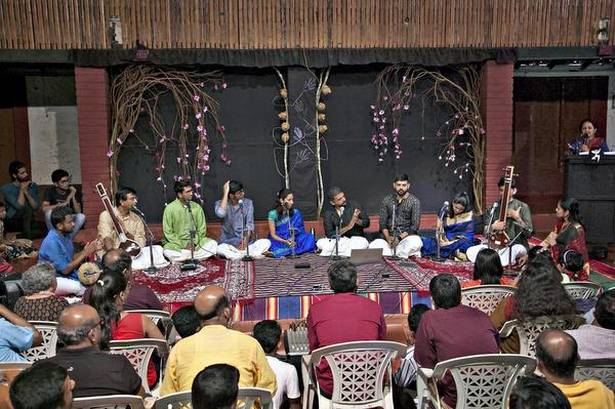
The Art Experience workshop at Ninasam, 2019.
The unsaid for musician T.M. Krishna is just as fascinating: with his team of seven students, he opened with a grand rendition of “Shri Nathadi Guruguho”, the Mayamalavagoula kriti from the set of guruguha vibhakti compositions. Deconstructing the kriti, he opened up the extraordinary imagination of Dikshitar who had transformed the beginner’s lessons of Carnatic music into something ethereal. “Look how the imagination of Dikshitar works. Do you experience art when you recite the sarale varase or the alankaram? This transformation is magical–if this doesn’t give you goosebumps, what else will?” Conjuring up a live classroom on stage, Krishna in a fairly detailed exposition demonstrated the workings of creativity, individual understanding, and the production of music. He stressed on the importance of repetition and boredom. When his lecdem moved to the aspect of concerts, Krishna brought to fore the other ‘unsaid’ aspects of music, which pertained more to the social practice of music and not it’s artistic. “Several lines are drawn, and they form the unsaid. Nobody asks questions, but they quietly align with these rules. The violinist knows where to sit, and how much to play. The ghatam and khanjira players know that they cannot take control of the percussion section…” so on and so forth. Art practice has to be deeply tied with the ethical, “else the experience is incomplete.”
But what is it that constitutes art experience and who determines it? Gopal Guru — editor, Economic and Political Weekly — made three observations. He began by referring to the non-Dalit performing the Dalit experience and the ambiguities within. Further, examining caste, using the example of Lavani folk musicians, he spoke of the manner in which the form has been absorbed by the entertainment business. However, even here, it is the caste that becomes the point of discussion and not the performance. Gopal Guru with the examples of Gandhi and Ambedkar, analyzed the politics of choice of clothes, and understood Gandhi as being one among the peasantry, while Ambedkar’s choice is a statement of rights. Art experience, therefore, is a kind of negotiation, added Sundar. “It is more than the utilitarian value of the object. It bestows a completeness to us and the object. It is about coming to terms with the unknown. The function of art is to change or interpret the social meaning of art objects.”
What happens after the performance, after you leave the theatre, after you watch dance, or listen to music? What remains after the theatre, asked theatre expert Rustom Bharucha, pointing to the fact that spectatorship is an area that has hardly been thought about in theatre, unlike cinema. “It is slightly better in the Indian context because Rasa theory is about the spectator. Abhinavagupta writes what happens during the performance but not after.” Expressing his discomfort with the fetishization of impermanence, he made a paradoxical proposition: ‘it dies and does not die.’ It lives in smarane (remembrance), he argued. “Experience has to be constructed and codified, and it has to be challenged. Lokadharmi has no place in what constitutes art experience, but that has to change.”
In a moving presentation that combined songs, excerpts from documentaries, and discourse, Kabir scholar, Shabnam Virmani observed that art experience attained completion in Kabir practitioners because they not only sang and danced to Kabir’s compositions but made him their own by composing their own Kabir. In a way, Kabir experience continued to live, even after the performance. A journey with Kabir was a movement from self to non-self to self, maneuvering between two and one. “This is the space beyond language, it is where you lose your located identity and transcend it.” Kabir privileged ‘listening’ over ‘seeing’ because the sight divides whereas sound unifies. Sunana is, therefore, a practice of consciousness. She sang a beautiful bhajan in which the bird does not ‘see’ (flee) the forest fire, but ‘listens’ to the long period of friendship with the tree.
Lakshmish Tolpadi, concluded, art experience is that which makes us aware of the latent. This could be sunana.
This article was originally posted at https://www.thehindu.com/ and has been reposted with permission. To read the original article, click here.
This post was written by the author in their personal capacity.The opinions expressed in this article are the author’s own and do not reflect the view of The Theatre Times, their staff or collaborators.
This post was written by Deepa Ganesh.
The views expressed here belong to the author and do not necessarily reflect our views and opinions.

